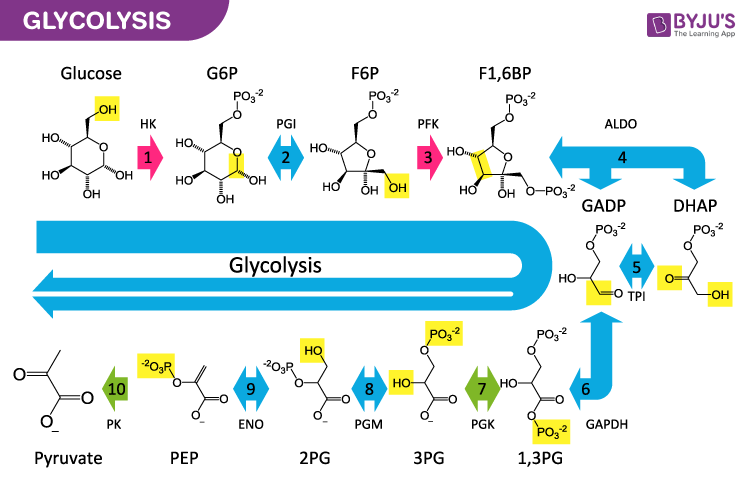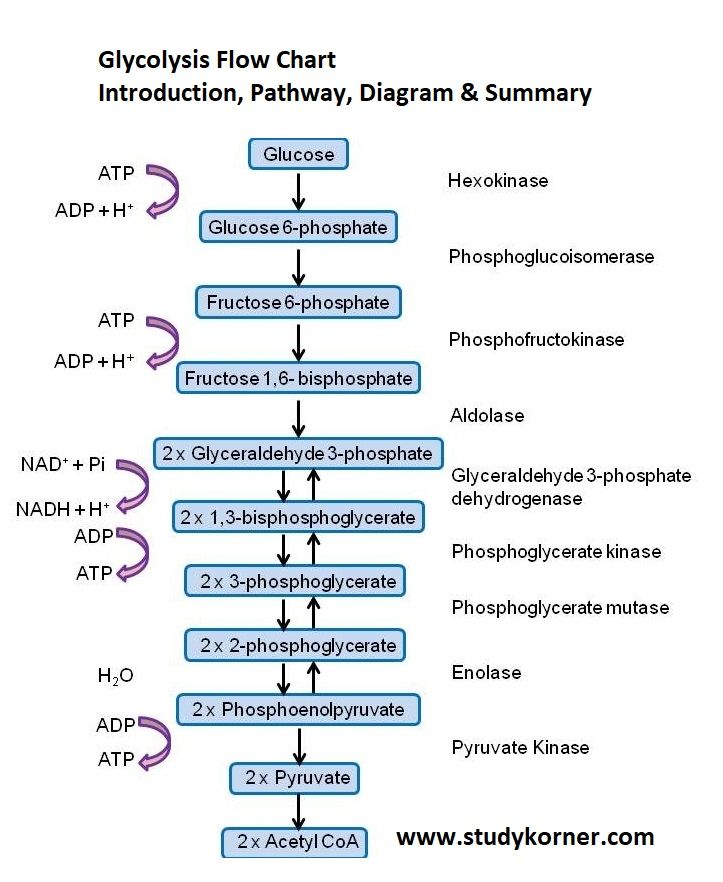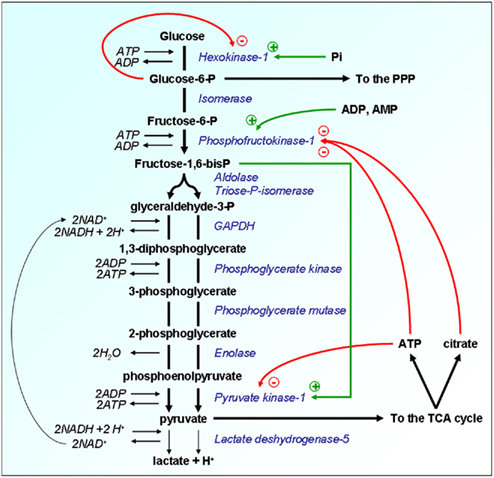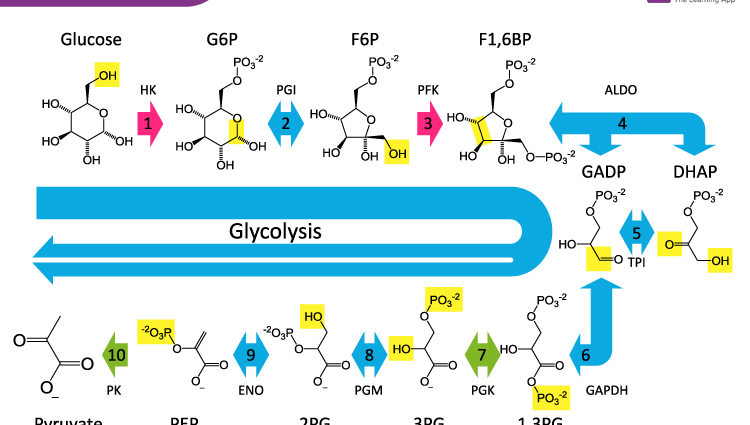
ABSTRACT:
In this article, we will discuss about the fascinating mechanism of glycolysis. Glycolysis is the process of production of cellular energy by the breakdown of glucose into pyruvate. Pyruvate, then entered into the citric acid cycle after decarboxylation. It is a crucial process to produce energy, occur in the cytosol or cytoplasm. We will also discuss about the enzymatic and feedback regulations of the cycle. We will also provide references to understand the concept deeply.
INTRODUCTION OF MECHANISM OF GLYCOLYSIS:
Glycolysis is a central metabolic pathway that plays a crucial role in energy production and the maintenance of cellular homeostasis. It is a highly conserved process found in almost all living organisms, from bacteria to humans. Understanding the mechanisms of glycolysis is essential for comprehending various physiological and pathological conditions, including diabetes, cancer, and neurodegenerative disorders. This article aims to explore the key steps and regulatory mechanisms involved in glycolysis, supported by relevant scientific references.
OVERVIEW OF GLYCOLYSIS:
Glycolysis is a series of enzymatic reactions that convert glucose into pyruvate, generating a small amount of ATP and reducing equivalents in the form of NADH. The pathway consists of ten distinct steps, each catalyzed by a specific enzyme.
MECHANISM OF GLYCOLYSIS:
1. PHOSPHORYLATION OF GLUCOSE:
The first step of glycolysis involves the phosphorylation of glucose by hexokinase, which traps glucose within the cell and primes it for further metabolism.
2. ISOMERIZATION OF GLUCOSE-6-PHOSPHATE:
In this step, glucose-6-phosphate converted into fructose-6-phosphate by hexokinase isomerase enzyme. This step is necessary to hold the energy inside the cell.
3. PHOSPHORYLATION OF FRUCTOSE-6-PHOSPHATE:
Phosphofructokinase-I enzyme catalyzes the phosphorylation of fructose-6-phosphate to fructose-1,6-bisphosphate, committing glucose to glycolysis.
4. CLEAVAGE OF FRUCTOSE-1,6-BISPHOSPHATE:
Aldolase enzyme cleaves fructose-1,6-bisphosphate into two three-carbon molecules, dihydroxyacetone phosphate (DHAP) and glyceraldehyde-3-phosphate (GAP).
5. ISOMERIZATION OF DIHYDROXY ACETONE PHOSPHATE:
DHAP is converted into GAP by triosephosphate isomerase, ensuring that both molecules can proceed through the subsequent steps.
6. OXIDATIION OF GLYCERALDEHYDE-3-PHOSPHATE:
Glyceraldehyde-3-phosphate dehydrogenase enzyme catalyzes the oxidation of GAP, generating NADH and high-energy phosphate bonds in the form of 1,3-bisphosphoglycerate.
7. TRANSFER OF PHOSPHATE GROUP TO 3-PHOSPHOGLYCERATE:
Phosphoglycerate kinase enzyme transfers a phosphate group from 1,3-bisphosphoglycerate to ADP, producing ATP and 3-phosphoglycerate.
8. HYDROLYSIS OF 3-PHOSPHOGLYCERATE:
In this step, 3-phosphoglycerate converted into 2-phosphoglycerate by the removal of molecule of water.
9. FORMATION OF PHOSPHOENOL PYRUVATE:
In this step, 2-phosphoglycerate converted into phosphoenol pyruvate.
10. FORMATION OF PYRUVATE:
The final step of glycolysis involves the transfer of a phosphate group from phosphoenolpyruvate (PEP) to ADP, generating ATP and pyruvate.

REGULATION OF MECHANISM OF GLYCOLYSIS:
Glycolysis is tightly regulated to meet the energy demands of the cell. Several key regulatory mechanisms ensure that the pathway is responsive to cellular needs and metabolic conditions.
1. ALLOSTERIC REGULATION:
Enzymes such as hexokinase, PFK-1, and pyruvate kinase are regulated by allosteric effectors. For example, ATP acts as a negative allosteric regulator of PFK-1, while AMP and fructose-2,6-bisphosphate stimulate its activity.

2. HORMONAL REGULATION:
Hormones such as insulin and glucagon modulate glycolysis by altering the levels of key regulatory enzymes. Insulin promotes glycolysis by activating phosphofructokinase-2 (PFK-2), which increases the levels of fructose-2,6-bisphosphate, a potent activator of PFK-1.

3. POST-TRANSLATIONAL MODIFICATIONS:
Glycolytic enzymes can be regulated through post-translational modifications, including phosphorylation, acetylation, and sumoylation. These modifications can alter enzyme activity, stability, and subcellular localization.
4. TRANSCRIPTIONAL REGULATION:
Transcription factors, such as hypoxia-inducible factor 1-alpha (HIF-1α), regulate the expression of glycolytic enzymes in response to oxygen availability and metabolic demands.
CONCLUSION OF MECHANISM OF GLYCOLYSIS:
Glycolysis is a fundamental metabolic pathway that provides energy and metabolic intermediates for various cellular processes. Understanding the mechanisms and regulation of glycolysis is crucial for unraveling the complexities of cellular metabolism and its implications in health and disease. Further research in this field will undoubtedly shed light on novel therapeutic targets and strategies for managing metabolic disorders and cancer.
REFERENCES:
Telang, S. (2013). YAPping about glucose: glycolysis and tumor cell growth. Cancer Biology & Therapy, 14(6), 490-491. https://www.ncbi.nlm.nih.gov/pmc/articles/PMC4223729/
Ralser, M., Wamelink, M. M., Kowald, A., Gerisch, B., Heeren, G., Struys, E. A., … & Lehrach, H. (2007). Dynamic rerouting of the carbohydrate flux is key to counteracting oxidative stress. Journal of Biology, 6(4), 10. https://jbiol.biomedcentral.com/articles/10.1186/jbiol61
DeBerardinis, R. J., & Chandel, N. S. (2016). Fundamentals of cancer metabolism. Science Advances, 2(5), e1600200. https://www.science.org/doi/10.1126/sciadv.1600200
Vander Heiden, M. G., Cantley, L. C., & Thompson, C. B. (2009). Understanding the Warburg effect: the metabolic requirements of cell proliferation. Science, 324(5930), 1029-1033. https://link.springer.com/referenceworkentry/10.1007/978-1-4419-9863-7_703



hey
cool blog 🙂 will give it a follow and a like !